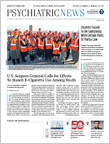For decades, cigarette smoking among youth in the United States has been falling. According to the Centers for Disease Control and Prevention, data from the 2015 National Youth Risk Behavior Survey suggests that the prevalence of cigarette smoking among U.S. high school students has dropped to the lowest levels since the survey was first conducted in 1991. However, a report released last month by U.S. Surgeon General Vivek H. Murthy, M.D., M.B.A., warns that such progress could potentially be hampered by the growing popularity of electronic cigarettes (e-cigarettes)—now known to be the most commonly used tobacco-related product among U.S. youth.
“This report makes the public—as well as the field of addiction psychiatry—aware of the silent epidemic of e-cigarette use among young people,” said Douglas Ziedonis, M.D., chair of the Department of Psychiatry at the University of Massachusetts Medical School. “It’s important that we, as addiction psychiatrists, have accurate information about e-cigarettes to help reduce such use among young people,” he told Psychiatric News.
The 298-page report focuses on the prevalence and potential harmful effects associated with e-cigarettes—battery-powered devices that heat nicotine-containing liquid into an aerosol to be inhaled by device users. The report cites extrapolated data from various surveys of U.S. youth ranging from age 11 to 24, including the National Youth Tobacco Surveys from 2011 and 2015 and the National Adult Tobacco Surveys from 2013 to 2014.
According to the report, e-cigarette use among U.S. middle school– and high school–aged students tripled from 2011 to 2015, with more than 3 million of these students—including approximately 1 of every 6 high school students—reporting to have used e-cigarettes in the past month in 2015. More than a quarter of middle and high school students reported having tried e-cigarettes at least once in 2015. The research showed that e-cigarette use among youth was strongly associated with the use of other tobacco-related products such as conventional cigarettes.
The prevalence of e-cigarette use doubled in adults aged 18 to 24 between 2013 and 2014—the most recent data available. Of the young adults surveyed, one-third reported having ever used e-cigarettes.
The most commonly cited reasons for youth using e-cigarettes was for flavor; 85 percent of e-cigarette users between ages 12 and 17 reported having used flavored products. According to the report, e-cigarettes are marketed to youth by promoting flavors and using a wide variety of media channels, including the Internet, television, and movies. In 2014, the e-cigarette industry spent $125 million on advertisements.
Other reasons for youth using e-cigarettes included curiosity and low perceived harms compared with other tobacco products.
“E-cigarette aerosol is not harmless ‘water vapor,’” Murthy wrote. “The health impacts of frequent exposure to the toxicants in e-cigarette aerosol are not well understood, though several are known carcinogens.” These carcinogens include benzene, which is found in car exhaust, and heavy metals, such as nickel, tin, and lead. Murthy added that ingestion of e-cigarette nicotine containing–liquids can also cause acute toxicity and possibly death.
At the end of the report, Murthy issued a call to action for approaches to reduce the public health threat posed by e-cigarette use to youth. This includes more research efforts investigating the negative consequences of e-cigarette use; public education of the current known dangers of e-cigarette use; continued regulation of e-cigarettes on the federal, state, and local levels; and curbing marketing approaches that are likely to attract youth.
“E-cigarette use among U.S. youth and young adults is now a major public health concern,” wrote Murthy. “Although we continue to learn more about e-cigarettes with each passing day, we currently know enough to take action to protect our nation’s young people from being harmed by these products. ... Preventing tobacco use in any form among youth and young adults is critical to ending the tobacco epidemic in the United States.” ■
“The U.S. Surgeon General Report on E-cigarette Use Among Youth and Young Adults” can be accessed
here.

